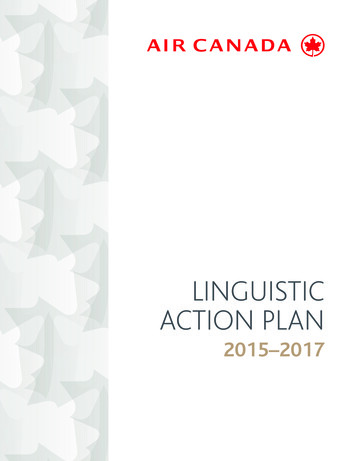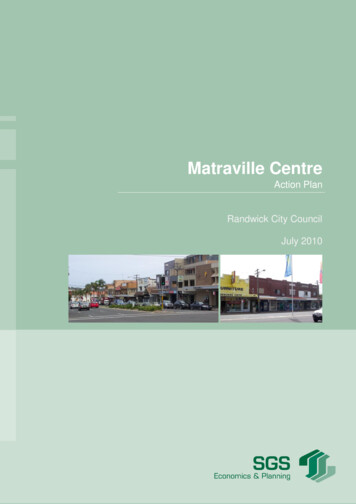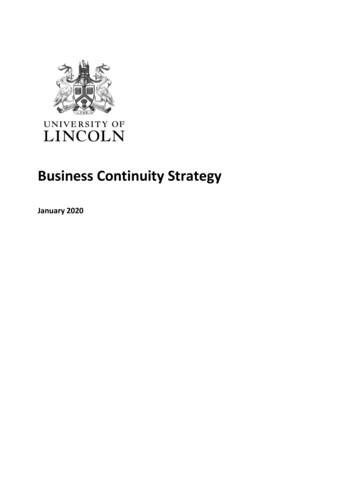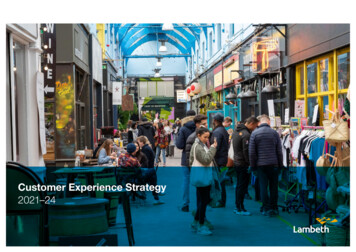
Transcription
Strategy and Action Plan of Special Needs Education,for the years 2009-2011Tbilisi20081
Definitions of TermsAdditional individual work – work of the teacher for the purpose of achievement ofgoals of the national plan, apart from the lessons (hours) determined by the nationaland school educational plans.Temporary supplementary classes – means the supplementary classes, temporarilyestablished in accordance with educational needs of the students, where they areprovided with an opportunity to overcome the difficulties, arisen during the learningprocess, e.g. lagging behind in a certain subject due to illness or other causes, catch-upclasses, etc. The necessity of existence of additional classes disappears, when all thestudents have overcome their learning difficulties.Daycare center – state program for facilitating integration and adaptation of the peoplewith disabilities, approved by the order of the Minister of Labor, Health and SocialAffairs, which envisages development of daycare centers of various profiles, that willcontribute to individual development of the people with disabilities (includingchildren) and their involvement in public life.Individual Educational Plan (IEP) – is a written document, the content, volume andthe rule for children with special educational needs of which are developed accordingto the level of academic preparation and interests of the student with specialeducational needs. The individual curriculum is compiled, assessed and reviewed bythe multidisciplinary team of inclusive education, the parent of the student with specialeducational needs and, where possible, by the student with special educational needshimself/herself. The individual curriculum is based on the national curriculum andtakes into account all the educational needs of the student with special educationalneeds, as well as the ways for satisfying these needs and all the additional activities,which are necessary for achieving the goals, envisaged by the individual curriculum.Inclusive education – implies involving the students with all types of specialeducational needs in the meanstream education, along with their peers. Inclusiveeducation also implies teaching the students with special educational needs based onindividual and/or modified curricula.Multidisciplinary team of inclusive education – is a team of specialists, whichincludes a psychologist, an occupational therapist, a speech therapist, a special teacherand a general education teacher. Composition of the multidisciplinary team maychange according to necessities. The following specialists can also be invited into theteam composition: a neurologist, a psychiatrist, an audiology teacher and/or any otherspecialist. A school may have a permanently functioning multidisciplinary team withinits school staff. Mobile multidisciplinary teams may also exist on the premises of themanagement bodies of the educational system (Ministry, resource-center).2
Functions of the multidisciplinary team of inclusive education are: a) Identifying andevaluating the children with special educational needs; defining their individual needsand abilities; b) Determining the educational interests of the child with specialeducational needs, based on assessment, and providing recommendations to parentsfor selection of the educational institution; c) Providing consultations to schools fordeveloping individual educational plans and effectively introducing them intoeducational practice; d) Practical and methodological assistance to schools inimplementation of the projects for introducing and developing inclusive education;forming a group in the school, which will be working on the issues of inclusiveeducation; e) Monitoring and assessment of academic and social achievements of thechildren with special educational needs, involved in the learning process in schools;identifying the factors which hinder inclusive education; developing the ways forresolving problems and the recommendations, which will define the actions, necessaryfor effectively implementing future activities. f) Identifying the children with specialeducational needs from databases of the resource-centers, district polyclinics and socialsecurity departments; supplementing the existing database.Integrated class – a class consisting of the children with special educational needs,where studies are conducted based on a special corrective program and which islocated within the space (building) of a general educational school. Students of theintegrated class are involved in all of the school activities (field trips, celebrations,exhibitions, etc.), apart from the educational process.Maximally supportive and least restrictive environment – implies that absolutemajority of the children with special educational needs receive education together withtheir peers, who do not have special educational needs and that children with specialeducational needs are redistributed to specialized schools only in the cases wheneducational needs of the child are so diverse and acute, that they cannot be satisfied in ageneral educational space.Modified curriculum – a component part of the national curriculum – a differenteducational plan for the students with special educational needs.Partial inclusion – refers to the special timetables of the student with specialeducational needs, in accordance with which this student attends only the lessonsenvisaged by his/her individual curriculum.Resource room – is a room, existing within the space of the schools of mainstreameducation, which is equipped with all the material-technical means that are necessaryfor meeting special educational needs of students: adapted furniture, various visualteaching aids, audio-video equipment, computer, printer, copier. Resource room isserved by the school psychologist, special teacher, speech therapist and all thoseteachers, who take part in the process of inclusive education of the children with specialeducational needs. Resource room is a part of the timetables of students with specialeducational needs, where they are provided with an opportunity to rest, according to3
necessity, or to study individually and/or in groups. Frequency and duration of thepresence of the student with special educational needs in the resource room is definedby his/her individual curriculum.‘Full’ inclusion – refers to the timetables of student with special educational needs,according to which s/he attends all lessons.Child (student) with special educational needs – all the children, who arecharacterized by the following: 1. physical and mental development disorders; 2. visualand hearing disorders; 3. speech, behavior and emotional development disorders; 4.those who need long-term treatment/hospitalization; 5. those who represent nationalminorities; 6. those who are vulnerable and 7. those are threatened by being excludedfrom the educational process, due to learning difficulties.Identifying and evaluating children with special educational needs – identification ofthe child with special educational needs implies revealing and determining disordersrelated to psychical development and learning difficulties of the child, while evaluationrefers to defining the nature, quality and causes of these disorders.Specialized school – a school, which conducts special and corrective educationalprograms, as well as the upbringing activities of the children deprived of parental careand the children with special educational needs.Special teacher – is a teacher with higher education, who is thoroughly well-acquaintedwith the issues of upbringing, development, education of the children with specialeducational needs, as well as with the issues of their integration into society. Specialteacher is capable of using in practice the techniques of psycho-pedagogical teaching,pedagogically evaluating the students with special educational needs and compilingthe individual educational plan. Functions of the special teacher also include helpingand assisting teachers of the general educational school in the process of inclusiveeducation of the children with special educational needs.Activities of a psychologist – imply the following: conduct of psychological andpedagogical tests; interpreting the test (assessment) results; obtaining, integrating andinterpreting all the information related to the child’s behavior and learning; providingconsultation to other members of the team, in order to plan the learning process to becarried out based on the information obtained as a result of testing, interviews withparents and behavior assessment and so that all of the child’s educational needs aremaximally taken into account; planning and conducting psychological consultationswith children with special educational needs and their parents; planning the behaviorimprovement strategies, together with teachers.Children (students) with disabilities - are the children, whose status is definedaccording to the diagnostic criteria of the category of people with disabilities.Specifically, such children, the vital functions of the body of which have been damaged4
as a result of illness, trauma, delayed mental or physical development, whichpredetermines full or partial decrease of the learning ability and/or substantialcomplication of daily life, which leads to temporary or permanent disability of theircapacities and the necessity of social protection.“The general educational schools, which are established based onthe principles of inclusive education are the most effectiveroute towards overcoming discriminative attitudes,creating a favorable environment, building an inclusive societyand achieving the universal goals of education.”Salamanca Declaration, UNESCO, 1994I. IntroductionReceiving education is a fundamental right of all children. The state is obliged toensure accessibility of education and equal opportunities for all children, regardlesstheir needs, ethnic, religious or racial origin.This Strategy has been developed based on the Constitution of Georgia, the Law ofGeorgia on General Education, the Law of Georgia on Vocational Education, the UNConvention on the Rights of the Child, the national curriculum of Georgia for the years2008-2009 and the international Program “Education For All”.For a long time, homogeneity in the educational system was a natural phenomenon forGeorgian society, which was part of the Soviet legacy. Children with specialeducational needs (hereinafter in the text: “children with SEN”) were strictly segregatedfrom society and did not have the opportunity of receiving education in themainstream educational environment, together with peers. Changes in the sphere ofeducation of the children with special educational needs began to be implemented bythe NGO sector from the year 1994, although this issue still remained beyond the scopeof attention of the state.Education of the children with SEN, was recognized by the state, as a priority, from theyear 2004, when a reform of the education system began. Government of Norwayprovided substantial financial and methodological assistance to the process ofintroduction of inclusive education in Georgia. The National Curriculum andAssessment Center of the Ministry of Education and Science implemented the Project:“Introduction of Inclusive Education in 10 Schools of Tbilisi”, which “contributedgreatly to integration of the children with disabilities and socially isolated children intosociety”1.1Monitoring Report of the Child’s Rights Committee, 2007.5
Results of the project and experience of the NGOs made it apparent, that the state needsa uniform, agreed strategy and action plan in the sphere of education of the childrenwith special educational needs, which must reflect the necessary legislative,administrative and methodological changes.Educational needs of all children must be maximally reflected during planning andimplementation of the national educational policy. In the sphere of education ofchildren with special educational needs, countries are guided by the UNESCO Program“Education for All”, the goal of which is for all children, notwithstanding theireducational needs, to have the following opportunities, by the year 2015: To study in a general educational school, located near the place of the child’sresidence; To receive knowledge through diverse, flexible, academic and social skills-orientededucational programs; To be involved in an continuous educational process, including preschooleducation, vocational education, professional education and higher education; To fully participate in any aspect of the school and public life; To be an equal-rights student and to maximally develop his/her potential.By striving towards the abovementioned long-term goals, the Ministry of Educationand Science of Georgia, as a result of multilateral consultations2 and with support fromthe USAID and “Save the Children”, developed this Strategy and Action Plan for theyears 2009-2011. The indicated period was defined as the transitional, preparatorystage of the process of achieving the long-term goals of education of the children withspecial educational needs. Through implementation of the Strategy and Action Plan ofthe transitional period, the Ministry will contribute to methodological and materialtechnical perfecting of specialized schools and will begin introduction anddevelopment of inclusive education3.For the purpose of preparing the development and introduction of the Strategy, theMinistry will carry out several necessary measures. First of all, the Ministry willrenounce the accepted terminology and introduce the term: “child with specialeducational needs (CWSED).”4 Introduction of the term CWSED enables to avoid,The 15-member working group on elaborating of inclusive education, formed on the premises of theMinistry’s Childcare Department, includes representatives of the Ministry, mainstream educational andspecialized schools, University education, local and international NGOs and organizations of parents ofthe children with special educational needs.2The researches, conducted in the 1990’s by the United Nations Educational, Scientific and CulturalOrganization (UNESCO) in the sphere of education of the children with special educational needs, havemade it clear, that the most successful and internationally recognized model of education of the childrenwith SEN is inclusive education. Inclusive education is an approach, which ensures the accessibility, forall children, of the education corresponding to their capabilities and skills, in the context of generaleducation, i.e. in mainstream educational schools.34The Law on General Education, of 2005, and the National Curriculum of Georgia for the Years 20082009”.6
within the education system, the division of children according to the status ofdisabilities, learning skill, social condition, nationality or any other characteristic.Consequently, the Ministry defines the following children as the children with specialeducational needs: Children with disruptions of physical and mental development; Children with vision and hearing impairments; Children with speech, behavior and emotional development disorders; Children who need long-term treatment/hospitalization; Children who represent national minorities; Children who are vulnerable; Children who are threatened with being excluded from the educational process, dueto learning difficulties.Also, specialized and inclusive education of the children with SEN will not besuccessful and effective without adequate human/professional, material/technical andfinancial resources being supplied. At this stage, the Ministry will also turnspecialized schools into educational resource-units, to which there will be assigned thetask of facilitating education of the children with SEN, through sharing the approaches,methodologies and effective teaching strategies, developed by the Ministry.II. Principles and Values of the StrategyThe Ministry’s Strategy for education of the children with special educational needs isbased upon the following principles and values: The starting point of the educational policy are the educational interests of the child; It is necessary to ensure a high standard of education for all children; It is necessary to ensure equal opportunities for all students; Each student must be provided with the opportunity to study, together with peers,at a general educational school.III. Goals of the StrategyThe main goals of the Strategy of education for the children with SEN are as follows: To develop and introduce the national model of education for the children withSEN; To ensure accessibility of education for the children with SEN; To facilitate improvement of the quality of education of the children with SEN at thepreschool, primary, basic, high-school, artisan and vocational education levels; To support formation, between the state sectors, of an agreed, uniform vision.IV. Priorities of the StrategyThe Strategy comprises the 8 priorities listed below:7
1. To develop the national model of education for the children with specialeducational needsContext and justification: Currently there is a possibility of receiving formal educationfor the children with special educational needs in specialized schools in Georgia, whileinformal education can be received at the daycare centers. Inclusive education isaccessible only to a small part of the children with SEN, while the majority of thechildren with SEN remain without any education at all. In exceptional cases, childrenreceive education at home. Unfortunately, for the absolute majority of the childrenwith SEN, there exists no adequate system of evaluating the educational needs,appropriate curricula or a favorable environment for their education. This situation iscaused by the combination of many factors5, of which the main one is non-existence ofthe national model of education for the children with SEN, that would be orientedtowards creating the optimal educational environment for the child, proceeding fromhis/her specific educational needs and in which there would be clearly defined thefollowing: all possible forms6 of education for the children with SEN and relevantstandards.In order for high-quality education to become accessible to all children, there has to bedeveloped a national model of education for the children with SEN, the introductionand functioning of which will further be regulated by a normative Act and will besubject to monitoring. The national model of education for the children with SEN mustinclude the following components: The system for identifying the children with SEN and assessing their educationalneeds;The criteria and system for recommending educational institutions/programs,based on the results of identification and assessment of the children with SEN;Professional standards for the teachers (special teachers) of education of the childrenwith SEN;Standard rules for clarifying the types of inclusive education (integrated class,partial inclusion of the student with SEN in the general educational process,complete inclusion of the student with SEN in the general educational process andtemporary auxiliary classes) and introducing them, with the following necessaryminimum: list of necessary services; teaching materials and visual aids; thenecessary level of knowledge of the school administration and teachers in inclusiveeducation; responsibility of the administration and teachers, their work hours anddefining other activities; relations with educational resource-centers; requirementsReview and analysis of the Inclusive Education Policies and Practice: Assessment of existing situation inGeorgia and in other European and non European countries, Report USAID, Save the Children, 2008.56Inclusive education, specialized education, informal education at daycare centers and home education.8
towards assisting personnel and their work hours; list of auxiliary means, such astransportation, the minimum of physical adaptation of the environment, etc.Mechanisms for funding education of the children with special educational needs;Standard rules for managing the educational process of the students with SEN inconditions of general educational schools, specialized schools and daycare centers.The abovementioned rules include: the rules for compiling, implementing andmonitoring individual educational plans; the rules for evaluating academicachievements of students and transferring them to the next level;The system of attestation of the students with SEN.Objectives: Consequently, it is necessary for a group of experts on education of thechildren with SEN to develop the national model of education of the children withSEN, described above, and components of the indicated model should be established asstrategic priorities for action.Implementation:It is necessary to undertake the following actions:a) To form a group of experts on education of the children with SEN;b) Work of the expert group must be based upon research, evidence and bestexperience of the education for the children with SEN;c) The expert group should develop the national model of education for thechildren with SEN and it must be submitted for discussion by the public,including schools, educational resource-centers and the Ministry;d) The expert group should also develop and disseminate, from the name of theMinistry, a glossary of the terminology related to education of the children withSEN.2. To introduce the national model of education for the children with specialeducational needsContext and justification: Development and pilot testing of the national model ofeducation for the children with SEN, its guidelines, identification tool and relevantregulatory mechanisms will make it possible to introduce inclusive education on thescale of whole Georgia, as well as to strengthen the currently existing practice ofinclusive education.Objective: To begin introduction of the national model of education for the childrenwith SEN, on the scale of the country.Implementation:It is necessary to undertake the following actions:a) Under management of the Ministry of Education and Science of Georgia, withassistance from the expert group and resource-centers, to undertake completepiloting of the national model in all 9 regions of Georgia, while observingrelevant regulations and guidelines;9
b) Program grants should be allocated from the Ministry of Education and Scienceto those general educational schools, which have started or are starting theprocess of introduction of inclusive education. Such program grants can beallocated for the purpose of inviting a specialist to the school, for purchasingtextbooks and visual aids, adapting the educational environment and for specialmeasures;c) Results of the piloting should be submitted for discussion by the public,including schools, educational resource-centers and the Ministry;d) Introduction of the national model should be started, for which purpose thereshould be developed a plan for re-training of the teachers’ staff, a plan forforming and preparing multidisciplinary teams, a plan for re-training the schooladministrations and resource-centers;e) The abovementioned re-training plans should be implemented in all the schoolsand districts of Georgia;f) Monitoring of the process of introduction of inclusive education should beconducted, relevant analysis and recommendations should be prepared andannual reports should be produced.3. Regulations and guidelines of education for the children with special educationalneedsContext and justification: Introduction of the national model, in itself, implies that,along with the national model, there must be developed the regulations, necessary forits introduction and functioning, a list of rights and obligations and normativerequirements. Without such mandatory Acts, it will be impossible to introduce thenational model.Objective: It is necessary to create the regulations, guidelines and funding mechanisms,corresponding to the inclusive and special education. These changes should includethe following: Determining the structure of management of inclusive and special education,defining the units, duties and functions, included in it;Defining the funding mechanisms of inclusive and special education;List of the rights and obligations of the administrations and teachers of generaleducational and specialized schools;List of the rights and obligations of parents and/or caregivers;Rules and requirements for preparing/re-training and certification of professionalstaff;The rule and criteria for accepting the children with SEN into general educationalschools, specialized schools and daycare centers;The rule for mobility of education of the children with SEN, description of the socalled “system of free circulation” and the norms and measures necessary for itsimplementation;10
Effective mechanism for relations and coordination between agencies.Implementation:a) The expert group should develop the relevant guidelines, regulations andrequirements;b) Guidelines, regulations and requirements must be discussed by themultidisciplinary teams, resource-centers and the Ministry;c) Final approval of the guidelines, regulations and requirements should takeplace, they should be published and disseminated to all the educationalinstitutions and resource-centers.4. Introduction of the tool and system for identifying the children with SEN andassessing their educational needsContext and justification: Identification of the children with SEN and assessment oftheir educational needs does not take place in Georgia; decisions related to education ofthe children with SEN depend completely upon whether they have the disability status.Planning of the state policy through such an approach may predetermine incorrectdistribution of resources. For example, many children with the status of ‘people withdisabilities’, such as for example those with diabetes or asthma, do not have specialeducational needs7; on the other hand, children who manifest the syndromes of lack ofconcentration and of hyperactivity, dyslexia, or other reading, writing or speechdisorders, do not have the status of persons with disabilities, although they do havespecial needs in terms of education. Children representing national minorities andvulnerable groups of population (street children, IDPs, etc.), as well as all thosechildren, who are facing difficulties in the learning process, due to various reasons, alsorequire assessment and identification of educational needs.Non-existence of identification of educational needs significantly hampers developmentof the necessary educational recommendations and leaves the parents in an unclearsituation. The latter are unable to make an informed choice as to where should theirchildren be studying: in a general educational or a special school, at home or at adaycare center.Educational work of the currently existing specialized schools is also substantiallyhampered exactly due to non-existence of a system of identification of needs.8 Childrenare not being accepted into these schools based on any standard, fair and universallyacceptable system; it is also impossible to determine capabilities of the child and todevelop the individual plan for his/her education.The study, conducted in 2008, in Kutaisi by the NGO Save the Children and the Coalition forIndependent Living demonstrated that only 45 of 142 children with a disability status (within the agecategory of 5-12 years), had special educational needs, 22 of which were not attending school.78There is the total of 13 specialized schools in Georgia.11
Due to lack of a system of identification of educational needs, creation of a system ofassessment of education and progress of education of the child is also being delayed,non-existence of which, in its turn, makes it impossible to objectively evaluate theresults of education and to introduce a system of free educational plan of the childwithin the educational space.Objectives: Consequently, it is necessary to:1. Create a valid and standardized tool for assessment of educational needsof the child, which will single out the strengths and weaknesses of thechild’s skills and capabilities and will evaluate the following: a) highestpsychical functions of the child, such as perception, attention, memoryand speech; b) academic functions, such as writing, reading, counting; c)motor and emotional functions and d) adaptation, self-serving, daily lifeand social skills;2. Development and introduction of such tools on the scale of the countrywill create the following possibilities: each student will be able to becomemaximally involved in the educational process; it will be possible toeffectively plan the programs supporting education of the children withSEN, to improve the mechanism of funding inclusive education and tocreate an accurate database of the children with special educational needs.3. Develop the regulations and procedures for identification and assessmentof the children with SEN; define the groups, responsible for andauthorized to determine the with SEN status.Implementation: It is necessary to undertake the following actions:a) The expert group on education of the children with SEN, based on review,adaptation and standardization of various existing tests, should develop a toolfor identifying the needs of the children with SEN and the methods for itsintroduction. This tool should then be submitted for discussion by the public,including schools, educational resource-centers and the Ministry;b) The tool should be pilot-tested in all 9 regions of Georgia;c) The final, tested version of the tool for identifying the children with SEN andassessing their educational needs should be approved and multidisciplinaryteams should begin studying and introducing this tool;d) Multidisciplinary teams should be formed (where they exist – strengthened) onthe premises of every educational resource-center in Georgia, so that in thefuture the following
teaching aids, audio-video equipment, computer, printer, copier. Resource room is served by the school psychologist, special teacher, speech therapist and all those teachers, who take part in the process of inclusive education of the children with special educational needs. Resource room is a part of the timetables of students with special











